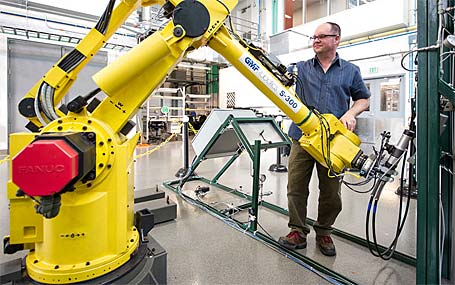
DOE’s National Renewable Energy Laboratory (NREL) is helping to build out the burgeoning hydrogen car infrastructure. Yesterday I talked about the DOE (Department of Energy) and how their PNNL division was helping with similar efforts.
But the NREL is taking a different angle at the issues. According to the NREL, “NREL hydrogen researchers are working with auto manufacturers, component vendors, and others to take a hard look at both the infrastructure and the cost challenges. NREL’s new ESIF includes 7,000 square feet of lab space built for hydrogen and fuel cell research. Approximately 50 researchers contribute to hydrogen or fuel cell related tasks, including production, storage, codes and standards, technology validation, and analysis.
“Researchers at NREL are examining the best ways to create hydrogen via electrolysis using wind and solar power. The most common way to produce hydrogen today is through steam reforming of natural gas—a tried-and-true approach, but one that generates greenhouse gases.
“Just a few months ago, the Energy Department’s Fuel Cell Technologies Office, within the Office of Energy Efficiency and Renewable Energy, which supports NREL’s research at the ESIF, announced more than $7 million for projects in Georgia, Missouri, Pennsylvania, and Tennessee that will help bring cost-effective, advanced hydrogen and fuel cell technologies to market faster. In the past five years, fuel cell durability has doubled; since 2005, the amount of expensive platinum needed in fuel cells has fallen by 80%, according to the Energy Department.
“Pivovar predicts that hydrogen fuel cell vehicles will take off first on islands such as Hawaii or Japan where a car can’t get too far away from the nearest refueling station and fuel costs are often higher, and metropolises such as Los Angeles where smog provides an extra incentive for clean engines …
“… NREL is analyzing the barriers and costs associated with installing enough hydrogen refueling stations to make fuel cell vehicles viable. One intriguing shortcut is to use existing natural gas lines to distribute hydrogen. Studies are exploring limiting hydrogen concentrations to less than 15% of the gas in the lines to avoid issues such as hydrogen embrittlement and to reduce the high capital costs of installing completely independent infrastructure.”
Another way that NREL is helping is by testing the quality of the hoses used at hydrogen fueling stations to refuel vehicles. With the use of robotics (pictured at top) NREL is testing the quality, durability and safety of the hoses.
Here’s a nifty 2:46 video showing the robot being put through its paces. This also brings to mind if there will ever come a time when robots such as this will be at the stations to refuel vehicles directly. I think a refueling robot based on smart technology will be just what the doctor (PhD) ordered. 🙂